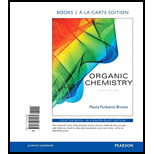
Interpretation:
- The kinetic and
thermodynamic products of the given reaction has to be predicted.
Concept Introduction:
Reactions of conjugated dienes:
An electrophilic addition reaction to a conjugated diene forms both
Kinetic and thermodynamic products:
Kinetic product: The more rapidly formed product is called the kinetic product. The reactions that produce the kinetic product as the major product are said to be kinetically controlled. The kinetic product predominates when the reaction is irreversible.
Thermodynamic product: The more stable product is called the thermodynamic product. The reactions that produce the thermodynamic product as the major product are said to be thermodynamically controlled. The thermodynamic product predominates when the reaction is reversible. The thermodynamic product is the product with the most highly substituted double bond.
Rule: The stabilities of carbocation are,
Want to see the full answer?
Check out a sample textbook solution
Chapter 8 Solutions
Organic Chemistry, Books a la Carte Edition (8th Edition)
- For the following reactions at constant pressure, predict if HE,HE,orH=E a. 2HF(g)H2(g)+F2(g) b. N2(g)+3H2(g)2NH3(g) c. 4NH3(g)+5O2(g)4NO(g)+6H2O(g)arrow_forward1. Calculate the standard reaction free energy of the following chemical reaction:arrow_forwardGiven the following data: 2 03(g) → 3 0₂(g) 0₂(g) → 2 0(g) NO(g) + 03(g) → NO₂(g) + O₂(g) calculate AH for the reaction NO(g) + O(g) →→ NO₂(g). KJ ΔΗ = −286 kJ ΔΗ = +498 KJ ΔΗ = – 199 kJarrow_forward
- Using the thermodynamic informationn, claculate the standard reaction free energy of the following chemical reaction: Fe2O3(s)+3H2(g)---> 2Fe(s)+3H2O(l)arrow_forwardThe standard free energy change for the reaction CH4(g)+2O2(g) -> CO2(g) + 2H2O(l) is -194.8 kcal at 25ºC and -191.82 kcal at 75ºC. Calculate the heat of reaction at 25ºC.Ans: -212.6 kcalarrow_forward22. Which statement is false? (a) If a reaction is thermodynamically spontaneous it may occur rapidly. (b) If a reaction is thermodynamically spontancous it may occur slowly. (c) Activation energy is a kinetic quantity rather than a thermodynamie quantity. (d) If a reaction is thermodynamically nonspontaneous, it will not occur spontaneously. (e) If a reaction is thermodynamically spontaneous, it must have a low activation energy. 23.arrow_forward
- oxygen Photosynthesis in plants converts carbon dioxide and water into glucose (C,H,O) and according to the equation below. 6CO₂(g) + 6H₂O() - CH₂O() + 60₂(g) Substance CO(g) H₂O(1) C₂H₁₂O(s) O(g) AHi(kJ/mol) -393.5 -285.8 -1273.3 0 SᵒJ/mol K) 213.6 69.9 209.2 205.0 Calculate the AH, AS, and AG. Is the reaction spontaneous at standard conditions?arrow_forwardAt equilibrium, the free energy of the reactants is equal to the free energy of the products. true or falsearrow_forwardThe overall reaction energy (gibbs enegy) is negative How could you explain the favorability of the reaction in terms of enthalphy and entrophy?arrow_forward
- 2b which determines whether a reaction is spontaneous. the net free energy change of the reaction or the activation energy of the reactionarrow_forwardThe difference in standard free energy between reactant R and product P is + 7.5 kJ/mol. What’s the ratio of P to R at equilibrium? P to R ratio =arrow_forwardGiven that S(g) + O2(g) → SO2(g) A,G° = -300.1 kJ/mol-rxn 2 S(g) + 3 O2(g) → 2 SO3(g) A,G° = -742.1 kJ/mol-rxn calculate AG° of the following reaction: SO2(g) + 1/2 O2(g) → SO3(g) O -1042.2 kJ/mol-rxn O -71.0 kJ/mol-rxn O +2.47 kJ/mol-rxn +1042.2 kJ/mol-rxn O +71.0 kJ/mol-rxnarrow_forward
- Chemistry: Matter and ChangeChemistryISBN:9780078746376Author:Dinah Zike, Laurel Dingrando, Nicholas Hainen, Cheryl WistromPublisher:Glencoe/McGraw-Hill School Pub Co
 Chemistry: The Molecular ScienceChemistryISBN:9781285199047Author:John W. Moore, Conrad L. StanitskiPublisher:Cengage Learning
Chemistry: The Molecular ScienceChemistryISBN:9781285199047Author:John W. Moore, Conrad L. StanitskiPublisher:Cengage Learning Chemistry: An Atoms First ApproachChemistryISBN:9781305079243Author:Steven S. Zumdahl, Susan A. ZumdahlPublisher:Cengage Learning
Chemistry: An Atoms First ApproachChemistryISBN:9781305079243Author:Steven S. Zumdahl, Susan A. ZumdahlPublisher:Cengage Learning


